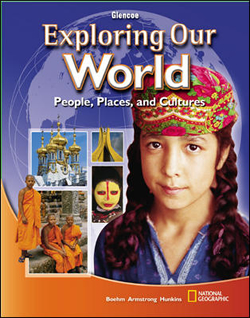Exploring Our World: People, Places, and CulturesChapter 1:
Using Geography SkillsWeb Activity Lesson PlansIntroduction
In this opening chapter, students learned that the Earth’s location in the solar system affects the planet. The way the Earth tilts, rotates, and orbits has an effect on Earth’s physical systems and human life. This Web site provides information about the solar system, including information about NASA’s most recent scientific discoveries. Lesson Description
Students will visit the National Aeronautics and Space Administration (NASA) Web site to learn about the solar system. After reading about each planet and other smaller bodies in space, students will answer questions about the solar system. Students can use the illustration of the solar system in the textbook as they read about each planet. Instructional Objectives
- The learner will be able to recall specific facts about the solar system.
- The learner will be able to describe how an event in space affected life on Earth millions of years ago.
- The learner will be able to explain the differences in definitions for similar vocabulary words.
Student Web Activity Answers
- Venus
- Spacecraft is expected to explore Pluto and then travel to the Kuiper Belt. This region contains icy objects that NASA hopes to examine.
- New objects are found, and technology helps scientists learn more about the makeup of existing objects.
- It altered life on Earth and is believed to have caused the extinction of the dinosaurs.
- Meteoroids are chunks of dust and material from the solar system that travel through space. Meteors are the bright trails of bits of material coming through and burning up in the Earth's atmosphere. Large pieces that do not vaporize completely and reach the surface of the Earth are meteorites.
 | 




